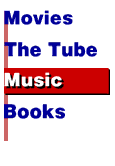|
|
||||
|
NOVEMBER 1998
|
FEATURE LAST | 80's Music Trivia
NEXT | Rush: Different Stages
ARCHIVES | Music
THE BRIAN SETZER ORCHESTRA
DREAM THEATER - Kevin Ridolfi |
The Great Swing Revival KEVIN RIDOLFI The decade from 1935-1945 was nicknamed the "swing era" due to the popularity of a new type of jazz - a powerful style performed by big bands rather than the more intimate qualities of the New Orleans style. The success of swing can be originally traced to the prohibition of alcohol in 1933. The Big Bands' sound easily filled large dance halls and ballrooms and consequently a dance craze was born, giving people a form of entertainment like no other before it. In that decade, some huge jazz names were established as true American music "stars" - again, something America had never truly seen. Amazingly, for the time, the bands transcended skin color and appealed to everyone whether they were black or white. The popular swing bands of the "swing era" - Duke Ellington, Count Basie, Glenn Miller and Benny Goodman to name just a few - can be equated to the superstar rock groups of the 1980's and 1990's. The typical swing band consisted of about 14 musicians grouped into three sections: saxophones, brasses (trumpet, trombone) and rhythm (bass, piano, guitar and percussion). These large groups of musicians stood in easy contrast to the five piece New Orleans style jazz a bands of the 1920's. Another differentiation was that while New Orleans-style jazz was, in large part, improvised, swing bands used arranged compositions for there pieces. The large scale setting allowed two important changes to take place in the jazz world. First, it allowed the saxophone to become one of the most important solo instruments. Secondly, percussionists, led by the flamboyant Gene Krupa, held a much greater role by keeping the beat in new innovative ways as well as taking lengthy solos themselves. The phenomenon of drum solos at modern rock show can trace its roots to the aggressiveness and abilities of Krupa and Buddy Rich. The 1940's saw a decline in swing music due in part to the enormous expense of supporting such large bands. Be-bop replaced swing as the jazz musician's style of choice. For the next five decades swing bands decreased in number until the only traces of the big band remained on American late night talk television. That was until now with the revival of the swing band and swing dancing. Why would this happen all of a sudden in a decade of tortured artists and musical minimalism? Well, it happened for exactly those reasons. When Pearl Jam and Nirvana burst loudly onto the music scene in 1991, they helped change music from the over-indulgent, party stylings of the eighties to a more reflective (and in the case of Nirvana's Kurt Cobain, depressive), dark expressive tone. Music in the 1990's grew through stages of expressionism where the artists wore every hurt feeling and every dark thought out in the open and punctuated the hurt with dissonant blasts of distorted guitar. This led to further self-indulgence and self-absorption with the advent of electronic and computerized music. What could be more introverted than being able to play four parts by yourself and never having to tour? Finally, music fans had enough minimalism and, quite simply put, wanted to have fun again. It's tough enough growing up in the face of political correctness, constant and dangerous drug lifestyles, and more violence than ever before without having to face a dark, pessimistic musical environment as well. Music, throughout history, has been used to promote optimism and happiness and the youth culture needed that in their life's again. Enter swing, the music of their grandparents. The music that allows them, even encourages them, to dress up and have a good time without wading through layers upon layers of negative, and crushing, music. Following quickly on the heels of the hybrid ska and cross-over groups, swing is back with a vengeance as epitomized (and further influenced) by the summer's Gap Khakis spots depicting decidedly happy teens in the movement and passion of a swing dance. Suddenly swing dancing classes and dance halls are spring up where techno dance clubs dominated just a year ago. The music is being fronted by young, hip musicians who were influenced in music schools by the classic Basie and Ellington vinyls, but paid their dues playing punk and ska. The current heavies all have several qualities in common dynamite percussive attacks, blistering horn sections and frontmen with a lot of attitude. Two bands started the revitalization: The Brian Setzer Orchestra, which was started by the former Stray Cats guitarist and vocalist, and Squirrel Nut Zippers, who grew a cult following for years before the genre latched on again. They are know joined by several other notable bands such as Cherry Poppin' Daddies, Royal Crowne Revue and Big Bad Voodoo Daddy. Setzer is the most experience is given better treatment and exposure from his record company, but that is all changing thanks to radio and television exposure as well as the constant touring that was such an important feature sixty years ago. The saying states that everything will eventually come full circle and if this revival continues, it'll be the odd man out whose not wearing the Zoot suit and stepping out for night of swing. KEVIN RIDOLFI of Pawtucket, RI, is the creator and editor of Renaissance Online Magazine. He can be reached at [email protected] |
|||
 |
||||
|
Complete Contents | FEEDBACK | Questionnaire | Archive | Author Biographies | Mailing List |
||||



